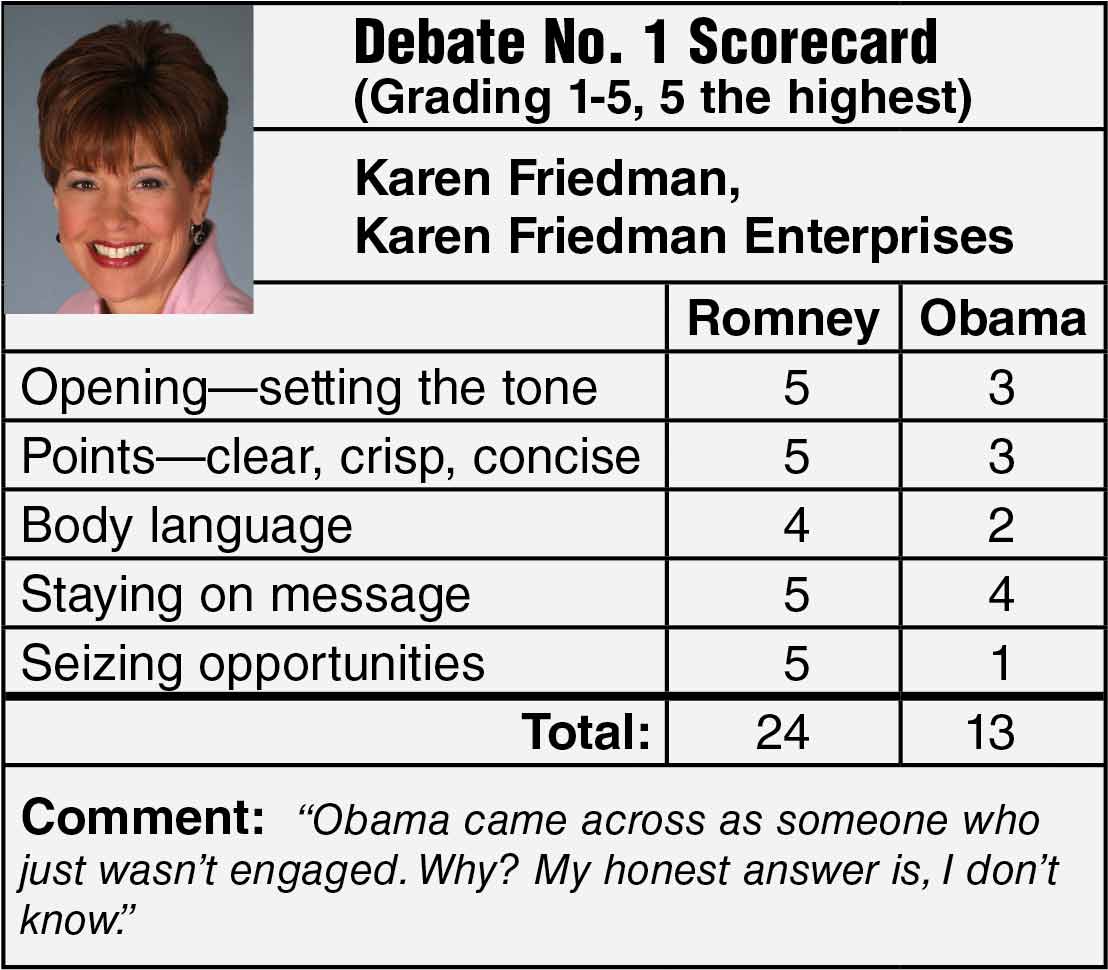By the time President Obama and Republican challenger Mitt Romney took to the debate stage on Wednesday, Oct. 3, much had been written about their extensive preparation. Romney was reportedly holed up for days with briefing books, top aides and his sparring partner, Ohio Republican Sen. Rob Portman—while working on “zingers” that would trip up the President.
Meanwhile, Obama had been sequestered outside of Las Vegas, and was quoted joking to a volunteer in a local field office: “It’s a drag. They’re making me do my homework.”
Hmmm. A sign of things to come?
To be sure, the PR discipline of media training is getting a boost during this presidential season, particularly as the series of debates (including the VP square-off between Republican Paul Ryan and incumbent Joe Biden on Oct. 11) gets underway. And while the stakes are up in the stratosphere for Obama and Romney, there are plenty of debate takeaways for merely mortal PR pros to incorporate in their own media training exercises for their leadership.
 |
Whether it be annual meetings, conferences, panel discussions or debates, it’s all about the messages, says Liz Miklya, vice president at Weber Shandwick. And to craft the right messages, study the audience. “Listen to what is being said, and what the audience wants to hear from your leadership,” says Miklya.
In the case of Romney and Obama, voters have said they are most interested in both candidates’ specific policy stands. “You just can’t throw abstract messages out there,” says Miklya. “You must get down to specifics.”
Conversely, problems arise when leaders stay slavishy on message when asked a question by a reporter or broadcaster. “They can’t go right into the message points,” says Miklya. “You have to respond to the question, and not force the message.”
When it comes to messaging, Miklya says to think in soundbites—what do you want to see in reporters’ articles or on video clips after the appearance? Attention-getting phrases or soundbites, of course.
FOLLOW THE 3 P’s
 |
For communications coach Karen Friedman, head of Karen Friedman Enterprises, a successful speaking engagement or interview involves the 3 P’s: presence, passion and purpose. And in debate No. 1, Romney exhibited those in spades. “He was forceful, yet he wasn’t angry,” says Friedman. “For the first time to me he seemed a little more human and personal, rather than aloof and stuffy.”
While audiences care about factual accuracy in public statements, speaker style, engagement and animation is even more critical to wooing them to your side, says Friedman.
And it’s important to establish the 3 P’s from the get-go, says Friedman. “You have to come out strong in any interview or public appearance,” she says. “The opening sets the tone and pace for the rest of the conversation.”
SHOW FORCE
 |
In some situations, your leader has to be forceful to get the point across. That is where Obama fell short, says Andy Gilman, president and CEO of CommCore Consulting Group.
Using a fitting basketball analogy with the hoops-loving President, Gilman counted three or four instances where Obama was given lay-ups by Romney, but he passed the ball instead. Indeed, pundits were puzzled by Obama’s reluctance to bring up the 47%, Bain or Romney’s personal tax situation when opportunities presented themselves.
DO THE STARE DOWN
What may have been worse for Obama was his body language, which Friedman says was anything but presidential. “Obama looked down at his notes or at the camera,” she says. Romney, on the other hand, looked directly at the President when making his points. “Good public speaking is a mix of body language and what comes out of your mouth,” says Friedman. “Obama failed to look directly at his opponent and say ‘you are wrong, here are the facts.’”
PUSH THE SPIN CYCLE
Of course, you’d never know of either candidate’s debate shortcomings that night when listening to their communications directors’ comments in the so-called “spin room” after the debate.
This is another tactic PR pros should put to work, says Gilman. Post event, always communicate the positive, put your leader in the best possible light, re-interpret any questionable statements and deflect criticism. “With the undecided in particular, spin matters,” says Gilman.
In addition, think of social media platforms as your own spin room. Twitter reported some 10 million tweets about the debate and the issues the candidates sparred over, making it the most tweeted-about U.S. political event ever. Make sure you use social media to reinforce your leader’s messages.
NEXT MOVES
The debate game is much like a game of chess, adds Gilman. The Democrats’ next move should be to “prepare the heck out of Joe Biden” and have him go on the attack against Ryan.
Meanwhile, Romney can’t keep his pieces in one place on the board. Gilman says that Romney’s team should create a more challenging set of facts that calls Obama’s leadership into question. “They must hit that up front in the next debate,” says Gilman.
For Miklya, the most important communications strategy for both candidates is to keep taking the public’s temperature in the days ahead, and adjust accordingly. “I tell our clients that their messages aren’t the 10 Commandments,” she says. “They need to be tweaked constantly to stay relevant.”
And that, my friends, is a PR checkmate.
CONTACT:
Liz Miklya, [email protected]; Karen Friedman, [email protected]; Andy Gilman, [email protected].
